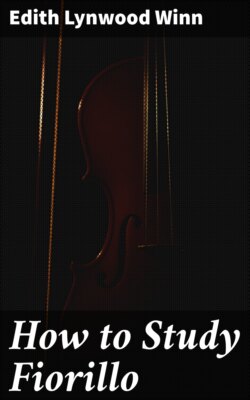Читать книгу How to Study Fiorillo - Edith Lynwood Winn - Страница 5
На сайте Литреса книга снята с продажи.
No. 2.
ОглавлениеTable of Contents
[Listen]
This étude is very frequently played in a mild manner, too slow for the original intention of the composer. As the allegro of the first étude is not possible at the proper tempo with the staccato bowing, so the second étude loses its character if not played in a martial style. Maestoso means military or majestic in character, with broad bowing and strong accents. The first two notes sweep the whole length of the bow. The third note is also full bow, but very short. A quick stroke, with the bow passing rapidly over the string, is the proper one. The whole exercise is played forte. In the second measure, the bowing is short and crisp at the point of the bow, the first group naturally being played with the whole bow. The third measure is legato, broad and free. Trills should be regular and of exactly the right length. All passages like the second measure are usually played at the point of the bow. After the first bar, some position work may be used (second measure). Trills with the fourth finger are very difficult for some players. Practice slow trills daily with the third and fourth fingers. The first finger trill should be practiced very slowly and evenly, great care being shown in string transfers at the close. In octave work two fingers must fall at once with force and precision. The whole hand moves. In double-stops, the fingers must fall simultaneously. Double trills are not much more difficult than single ones. They should be played with an even tone, and the fingers should fall with freedom. If the fourth finger is weak, try some exercises from the Halir Tonleiterstudien, repeating the exercises, faster and faster.
The measure immediately preceding the long continuous trills should be played with a down bow. Practice this passage without the continuous trill on C, at first (use a long smooth note and lightly dip the bow on the D string, as if playing a little accompaniment). Let the trill be continuous when changing from up to down bow and vice versa. Every note should be cut shorter if before a rest. This must be observed through the whole exercise. All chords should be played with a broad tone. This exercise, so often neglected, should be played long and faithfully, for it is the basis of other work which follows logically in study.
When playing the “22d Concerto” of Viotti, I always return to this étude of Fiorillo and review it for the sake of the trills. This, with a favorite étude of Kreutzer, aids me greatly in bringing my left hand under control. The octaves are played near the point of the bow.
[Listen]
This is one of the most artistic of the études, especially useful when one is considering such a work as the “22d Concerto” of Viotti. [2] Another useful work is “Je suis le petit Tambour,” by David,[3] a composition now almost obsolete in a violin teacher’s repertoire. Avoid a trivial style. The staccato is not absolute. The tempo and character of a work govern that matter. The second line has been marked in different ways by those who have revised Fiorillo. Note the Kross bowings:
[Listen]
I prefer separated strokes in passages like that of the second measure.
In double trills the fingers fall together with elasticity rather than force. Be very careful to define the exact interval in the trill. Do not disturb the tempo. Syncopation must not be forced. In trills in the half-position play close to the saddle of the violin, and do not raise the fingers until necessary. Play the chord of the new key as a chord, not as an arpeggio. The bowing is as follows, with a broader stroke than the staccato mark would indicate.
[Listen]
Do not disturb the theme by forcing the accompaniment or by pausing. The bow lies lightly on two strings, dips, as it were, upon the neighboring string, to obtain the legato. Bow control in this case is of great importance. Use the following bowings. The parts of the bow in which each passage should be played are indicated:
[Listen]
Play the last line with authority, the chords being slightly in the arpeggio style with a stress on the lower note, the tone being firm to the end of the bow.
[Listen]
